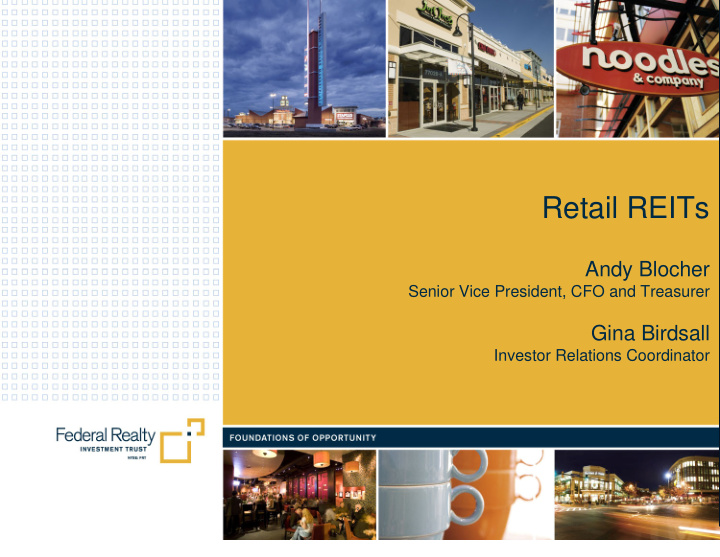



Retail REITs Andy Blocher Senior Vice President, CFO and Treasurer Gina Birdsall Investor Relations Coordinator
Who is Federal Realty Investment Trust? � One of the oldest publicly traded equity Real Estate Investment Trusts (REIT) � Shares are traded on the NYSE under the symbol FRT � Total market capitalization in excess of $5.4 billion (as of 12/31/08) � Paid quarterly dividends to its shareholders continuously since its founding in 1962 � Increased its dividend rate for 41 consecutive years, the longest record in the REIT sector � No single tenant accounts for more than approximately 2.6% of rental revenue � Strong total return performance over 20 years www.federalrealty.com
Core Markets Federal Realty’s assets are located primarily in strategic metropolitan Federal Realty’s assets are located primarily in strategic metropolitan markets in the Northeast, Mid-Atlantic, South Florida and California. markets in the Northeast, Mid-Atlantic, South Florida and California. BOSTON NEW YORK PHILADELPHIA SAN JOSE / BALTIMORE SAN FRANCISCO WASHINGTON, DC LOS ANGELES Core Markets Represent 28.3% of U.S. Retail Expenditures SOUTH FLORIDA Source: Merrill Lynch Research www.federalrealty.com
Washington Metropolitan Area Properties: 27 Cost: $1.09 Billion Avg. 3 Mile Population: 126,000 Avg. 3 Mile HH Income: $124,000 Demographic data provided by ESRI. www.federalrealty.com
Types of Retail Neighborhood and Community Centers • Grocery anchor • Typically necessity based small shop tenant mix • Strip center format with large parking lot and bank or restaurant pad sites •Trade area of 1 to 5 miles Trade area data provided by Merrill Lynch. www.federalrealty.com
Types of Retail Power Center • Big Box or “category killer” retailers • Little to no small shop space • Trade area of 5 to 10 miles Trade area data provided by Merrill Lynch. www.federalrealty.com
Types of Retail Mixed Use and Lifestyle Centers • Restaurant or entertainment anchors • Small shop mix a collection of boutiques, restaurants, gift shops, coffee shops, etc. • Often includes a plaza or community space, gives a “town center” feel • Trade area of 5 to 10 miles Trade area data provided by Merrill Lynch. www.federalrealty.com
Challenges facing Retail REITs • Slowdown in consumer spending, many consumers are “trading down” • Tenant bankruptcies, unexpected increases in vacancy • Tenants have more leverage when negotiating new deals • Retailers are finding it difficult to obtain loans in order to grow or open new businesses • Rent relief requests to landlords • Capital Markets are highly constrained – some REITs are unable to refinance debt, transactions market has slowed down, valuation has become difficult www.federalrealty.com
Retail Categories Category Popular Perception Grocers � � Restaurants Pharmacies � Fast-Casual Dining � Dry Cleaners � � Salon / Spa � Clothing Boutique www.federalrealty.com
Retail Differentiation Center #1 Center #2 Mainstream Grocer Gourmet Grocer Drugstore Collection of diverse restaurants Hair Salon Upscale Spa Pizza Restaurant Boutiques Dollar Store Luxury Shops www.federalrealty.com
Retail Differentiation Center #1 Center #2 Mainstream Grocer Gourmet Grocer Drugstore Collection of diverse restaurants Hair Salon Upscale Spa Pizza Restaurant Boutiques Dollar Store Luxury Shops � � www.federalrealty.com
Retail Differentiation Center #1 Center #2 Mainstream Grocer Gourmet Grocer Drugstore Collection of diverse restaurants Hair Salon Upscale Spa Pizza Restaurant Boutiques Dollar Store Luxury Shops Bethesda, Md. � Toledo, Ohio www.federalrealty.com
Key Considerations for a Changing Economic Environment Federal Realty: • Locations have the best supply and demand characteristics • No tenant accounts for more than 2.6% of our revenue base • Percentage rent comprises less than 2.0% of our rental stream • Not dependent on acquisitions to grow • Debt maturities are well-laddered • Very low leverage • Development pipeline is very manageable to its size and its profile • In-place leases are still significantly under market www.federalrealty.com
Recommend
More recommend